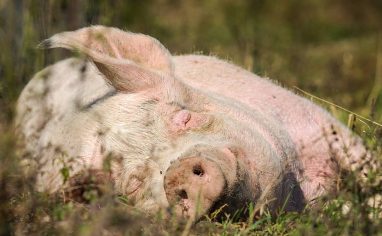
Subscribe To The Open Sanctuary Podcast
If you’d like to get the latest episodes of The Open Sanctuary Podcast, you can subscribe for free on all Podcast platforms, including Apple Podcasts and Spotify!
Episode Notes
Executive DirectorThe individual formally in charge of final decision making at an organization, who sometimes works closely with the organization’s Board of Directors. Sometimes a Founder is an Executive Director, especially early in a nonprofit’s growth stages. Mckenzee and NonprofitA non-governmental organization whose primary purpose is something other than selling goods or services. Specialist Julia dedicate an episode to a specific bird type: Pigeons! Pigeons may not be the first animals you think of when it comes to sanctuary, but they are very special individuals who, for many reasons, may find themselves in need of sanctuary, and they deserve individualized, compassionate care. We discuss some of their background, behaviors, and needs, and ways you can help them!
This Episode’s Referenced Open Sanctuary Project Resources:
- Language Choices At The Open Sanctuary Project | The Open Sanctuary Project
- Pigeons: How We Got Here | The Open Sanctuary Project
- A Guide To Safely Catching Stray Birds For Your Animal Sanctuary Or Rescue Part I: Supplies Helpful For The Safe Capture Of Birds | The Open Sanctuary Project
- Predator-Proofing For Bird Residents At Your Sanctuary | The Open Sanctuary Project
- Why Residents Shouldn’t Breed At A Farmed Animal Sanctuary | The Open Sanctuary Project
- Microsanctuary Resource Center
- Palomacy
Episode Transcript (Auto-GeneratedThe following content was transcribed through an automated process and may contain transcription errors or misspellings.)
Mckenzee Griffler: Welcome to another episode of the Open Sanctuary Podcast. I’m Mckenzee Griffler, executive director, and I’m chatting today with Julia Magnus, our nonprofit specialist and resident bird nerd. Today we’d like to dedicate an episode to a specific bird type which may not be the first you think of when it comes to sanctuary, but which are very special individuals who deserve individualized compassionate care. Let’s talk about pigeons. Let’s first note that pigeons sometimes evoke strong and sometimes contradictory reactions and they can often be subjected to harmful human exploitationExploitation is characterized by the abuse of a position of physical, psychological, emotional, social, or economic vulnerability to obtain agreement from someone (e.g., humans and nonhuman animals) or something (e.g, land and water) that is unable to reasonably refuse an offer or demand. It is also characterized by excessive self gain at the expense of something or someone else’s labor, well-being, and/or existence.. Out of sensitivity to our listeners, we will not get into graphic descriptions of animal cruelty, but we must mention it in order to provide a better context as to why our pigeon friends may find themselves in need of sanctuary. So, let’s get started. Julia, our resource on pigeons, how we got here, describes human associations around pigeons as paradoxical. Can you elaborate on what that means?
Julia Magnus: For sure. I find it truly fascinating. As on the one hand, you find that some individual pigeons have literally been celebrated as war heroes for their role as emergency message carriers in wars well into the 20th century. Yet, there’s an overwhelming tendency among humans, especially in cities sometimes, to stigmatize and denigrate pigeon species as a whole. Simultaneously, we continue to use and exploit them for their flesh, eggs, for target practice, and entertainment. Even as we continue to look down on them, it’s a very conflicted relationship that we have with them, and it’s why they often don’t immediately come to mind for sanctuary. I think it feels like stigma around pigeons is something that a lot of people might feel or have even experienced when they’ve care given for these birds and it seems arbitrary at times with people thinking negatively about some types of pigeons but not others. One striking example is the language we use about city pigeons like calling them flying rats while doves are vaunted as symbols of peace and love. Our resource points out that pigeons and doves are actually all members of the same family, the Columbidae family. Can you explain why making semantic distinctions between the two types is problematic? It’s really an important point to me and it does speak to the power and impact of language when we’re talking about living beings. Speaking of which, it’s really important to us at OSP to use language thoughtfully, respectfully. So, we do have a full resource on the importance of language use by itself, as well as we did a podcast on the subject, so we’ll list those in the show notes. So, coming back to pigeons, the terms dove and pigeon are strictly colloquial. They have no basis in scientific nomenclature. They are often used, as you said, to justify harmThe infliction of mental, emotional, and/or physical pain, suffering, or loss. Harm can occur intentionally or unintentionally and directly or indirectly. Someone can intentionally cause direct harm (e.g., punitively cutting a sheep's skin while shearing them) or unintentionally cause direct harm (e.g., your hand slips while shearing a sheep, causing an accidental wound on their skin). Likewise, someone can intentionally cause indirect harm (e.g., selling socks made from a sanctuary resident's wool and encouraging folks who purchase them to buy more products made from the wool of farmed sheep) or unintentionally cause indirect harm (e.g., selling socks made from a sanctuary resident's wool, which inadvertently perpetuates the idea that it is ok to commodify sheep for their wool). to some individuals while celebrating others. So, this is a form of speciesismA form of discrimination based on species membership; the belief that different species of animals deserve different ethical considerations regardless of whether they have similar needs or interests., which is discrimination based on species membership. And to circle back to your point about a common misinformed complaint that folks have about pigeons, which has to do with their cleanliness. Let’s point out both rats and pigeons, who are often stigmatized as unclean, are actually meticulous groomers. So, while any animal can harbor parasites or illness, they are not fundamentally toxic to humans. So, when we formulated this resource at the Open Sanctuary Project, we actively chose to refer to all members of the Columbidae family as pigeons, as we believe the term should be destigmatized and that all members of this bird family deserve equal respect and kindness. So, our choice was about countering these stereotypes and advocating for these beings. So, pigeons are part of the Columbidae family which consists of approximately 308 different species. At OSP, we think it’s really important to look at the ancestry and background of the creatures we care for as this can often inform a lot of caregiving decisions. What are some general characteristics that caregivers should know about for this diverse family? They’re really fascinating. So, the Columbidae family is found worldwide in almost all terrestrial habitats except for Antarctica. They usually fall into two categories, fruit-eating and seed-eating species. Their plumage colors can vary widely and they can be really spectacular, especially among the fruit-eating species. And the common appearance that they share is they have stocky body, short legs, short beaks. Actually, just speaking of beauty, the city pigeons, I was obsessed with them as a kidA young goat. I thought they were absolutely stunning. Like the iridescent purples and greens, just beautiful, just as beautiful as any parrot. So, another characteristic of pigeons which is relevant for anyone who might be thinking about taking them in to sanctuary or caring for them is looking at their lifespan. So, while feral pigeons might live 3 to 6 years, those who are kept in captivity can live 20 years or more. So, this extended lifespan means that there is a significant lifelong commitment in terms of care and costs for sanctuaries. Also, while this is human related and not bird related, due to the stigma surrounding pigeons, it’s really important to check your local ordinances if you’re considering offering them sanctuary as there can be legal restrictions around feeding, keeping, or caring for them. For example, in Chicago, while there is virtually no restriction on keeping farmed animalsA species or specific breed of animal that is raised by humans for the use of their bodies or what comes from their bodies. within the city, including roosters, there’s a flat-out ban on keeping pigeons. However, this does not stop some people from selling them labeled as doves, even though these doves are still members of the same family. And one final note that’s also human related. One thing to keep in mind about pigeons is that they have powdered down feathers, which are a specific kind of feather that they crumble and use to groom themselves. And that can make them a little dustier than other birds like roosters. For example, or certain kinds of parrots. So, that’s something to keep in mind in terms of living spaces and also human health. If you have folks with allergies, you’re going to want to make sure that you have good air quality going. Air filtration can help. There are tips for maintaining air quality and conditions for humans. If you take a look at the indoor chicken resource, we talk about that quite a bit.
Mckenzee Griffler: That seems like a really important note for potential pigeon caregivers to think about. And as you also said that they can live 20 years or more in captivity, which is quite a long-term commitment. What else is important for prospective caregivers to know? For instance, let’s talk about their behavior. The resource mentions pigeons are monogamous, which might be why certain species are seen as quote unquote symbols of love. Can you describe their social and mating behaviors?
Julia Magnus: Sure. I find their attachments to their partners particularly adorable as well as their behavior to one another. So, male pigeons can engage in some really impressive displays to attract females, which can include ground dances, calls, or even aerial displays, and it varies by species. Regarding breeding, pigeons can breed year-round or annually, and this kind of depends on resource availability. This is really important for sanctuaries to take note of. If pigeons are kept safely with abundant food, they might attempt to raise offspring year-round. So, sanctuaries have to monitor nests, promptly remove eggs from them, and substitute them with fake eggs. This will prevent inadvertent breeding, which is essential because sanctuaries are already so overwhelmed with animals needing care. Simply, just as a side note, simply removing eggs can actually cause females to lay even more, which can deplete their calcium reserves and cause them harm. If you give them fake eggs instead, it allows them to indulge in nesting behaviors without producing more offspring.
Mckenzee Griffler: That sounds like a very practical and compassionate approach for sanctuary settings. And as I’m sure our listeners will know, we’ve got a few resources on the importance of having non-breeding policies in sanctuary settings and the whys for that that you should definitely check out if you have any questions about that particular guidance. What about a pigeon’s social structure and intelligence? And I know there’s a lot of asterisks that will come in immediately when we say the word intelligence in regard to any species.
Julia Magnus: Absolutely. Well, let’s start with social behavior and then we’ll get to that. So, socially, most pigeons that you would encounter are happier in a bonded flock or pair. Sometimes pigeon flocks can number in the thousands and they do demonstrate hierarchical behaviors within these flocks similar to chickens. Also, like chickens, they are also prey animals. This means that they need safe predator-proof housing and aviaries to protect them from various predators. Please note as well, we do have a resource specific to avian predator-proofing, which we’ll also include in the show notes. So, as a matter of fact, pigeons’ short incubation periods, their frequent breeding, and their flocking behaviors are direct evolutionary responses to the threats of predation. Now, back to intelligence, which as you mentioned, we’ve got asterisks on this. Let’s just point out like chickens, they have a refined sense of magnetoreception, which uses two types of information from the Earth’s geomagnetic field for navigation. They can sense this visually and through iron-containing sensory dendrites and their beak areas. So, this special ability allows them to perceive direction, altitude, and location and even develop regional maps for themselves. Unfortunately, this special skill has been exploited, particularly in pigeon racing, which we’ll discuss a little bit more later. But do you want to do the asterisk on intelligence?
Mckenzee Griffler: Well, as I did ask the question, I must not be remiss to add in the asterisk, which is it’s really important to note just like the resource does that an individual’s right to be spared from exploitation should not be related to their perceived intelligence or any other ability. All sentient individuals deserve consideration and freedom from suffering.
Julia Magnus: Absolutely. Well said. That point is paramount. We discuss their abilities purely to understand their needs better and rescue and care. At times, it can be compelling to folks to know about these abilities, but it is not the basis upon which they deserve compassionate care.
Mckenzee Griffler: So, when I’m thinking about pigeon vocalizations, I’m mostly thinking about those sweet coos. How else do pigeons vocalize?
Julia Magnus: The sweet coos. While cooing is common, pigeons can also make many other noises, including wing claps, wing whistles, grunts, and hissing. Often, to alert their flock to threats and other behavior that’s arisen as a function of their status as a prey animal. Despite this, they are largely very docile, peaceful, and quiet birds. This can make pigeons excellent candidates for micro sanctuaries, especially in urban settings where you may have close neighbors and other bird species might potentially be a bit more disruptive. But again, please check your zoning rules before offering a home to a pigeon.
Mckenzee Griffler: So, let’s talk about the different “types” of pigeons in a sanctuary because as we said they’re all within the same family. But what kinds of pigeons might a sanctuary encounter and how can humans help them? And as always, we do want to underscore that anytime you’re considering care for a new species, it’s really important to consult experts beforehand.
Julia Magnus: Yeah, I want to underline that it’s critical. Pigeon rescue can sometimes involve complex questions about who needs veterinary intervention, who can be released, and which pigeons are particularly vulnerable. So, it’s really important to connect with skilled pigeon rescuers and especially veterinarians willing to work with pigeons as their invasive label might limit who will help them. I do want to note and we’ve included in the show notes that Palomacy is a really excellent resource. So, you can go there to connect with a lot of folks who are very skilled. So, as to pigeon types, in our resource we list three common types that rescuers often encounter. First, the rock pigeons. These are what most people envision when they think of pigeons. They were originally native to Europe, North Africa, and India, but human activities have expanded their ranges, making them a common sight in urban settings worldwide. They range from blue to gray, and they often have those barred markings and the beautiful iridescent coloring we were talking about earlier on their cropA crop is a pouched enlargement of the esophagus of many birds that serves as a receptacle for food and for its preliminary maceration. and neck. They typically roost on buildings and forage for food. They often might solicit food from humans. And variations in their coloration can occur due to crossbreeding with other pigeon breeds accidentally or intentionally released by humans.
Mckenzee Griffler: Speaking of coloration, I’ve noticed that white pigeons are noted as requiring special attention. Right.
Julia Magnus: Yes. In general, fully white birds are less likely to be pure rock pigeons and often may require fast rescue and special care. Due to the special risk of predation that they face, they’re very visible to predators. So, we’ll talk about that a little bit more in a few minutes. But back to rock pigeons. They’re incredibly hardy and they have adapted to new settings, which is why some people call them invasive. But we should reframe this narrative. Rock pigeons are here because of human interference. They’ve been exploited for food, eggs, message carrying in wars, racing, and even invasive research. So, calling them invasive flying rats ignores the fact that it is humans who have put them in these situations. And sadly, because they are considered nuisances, some municipalities may use non-compassionate pigeon control methods in massive “air quotes,” which might even include things like poisoning, shooting them, or capturing them for target practice.
Mckenzee Griffler: That’s a horrifying thought. And there’s also a specific condition you mentioned related to urban living called stringfoot.
Julia Magnus: Yeah, stringfoot is one of the most common and painful conditions that urban feral pigeons could suffer. So, in their natural habitats, they build nests from twigs or stems, typically in high areas like cliffs. But in urban settings, they might choose something like building ledges. And in urban settings, natural nesting materials are scarce. So, pigeons will creatively use whatever they find, which could be wires, string, even human hair. Sometimes these materials actually can get tangled up in their feet, cause lesions, circulation loss, infection, necrosisNecrosis is the death of most or all of the cells in an organ or tissue due to disease, injury, or failure of the blood supply., sometimes even limb loss. How can rescuers help with stringfoot?
Julia Magnus: So, pigeons are super resilient and sometimes even with missing toes, they can thrive. If you spot pigeons with stringfoot, you can lure the flocks with pigeon-appropriate seeds and net individuals with stringfoot. If you can detangle their feet and get them veterinary care, it can relieve them of a dangerous condition. Sometimes after treatment, and again, this is where you should be consulting with experts, urban pigeons can often rejoin their flocks. It’s a very tangible way to make a difference to these individuals. Again, cannot emphasize this enough. Consulting vets and experienced rescuers is an absolute must before trying to do this work so you can learn to do it properly and get informed advice that is crucial for decisions like releasing recovered pigeons.
Mckenzee Griffler: Moving on from rock pigeons, what’s the next most common type encountered in rescue?
Julia Magnus: So, this next group that we’re going to talk about is racing pigeons. To circle back, pigeons have been exploited for human entertainment and gambling for a very long time. And rock pigeons and other species have been selectively bred for their homing abilities and physical characteristics that favor long-distance flight. So, pigeon racing involves taking birds hundreds of miles from their homes and releasing them. And then the fastest ones to return are called winners. And there can be really huge sums of money involved in gambling on this activity. So, as a result, racing hobbyists breed, sell, and buy birds for large sums. The tragic reality of this practice is that not everyone’s going to make it home. Many birds can die en route. They can get injured or get lost and be permanently separated from their families.
Mckenzee Griffler: That’s really unfortunate for a number of reasons.
Julia Magnus: Yeah, the animals and entertainment stuff really gets me down. But you can identify racing pigeon survivors. So, a racing pigeon who fails to find their way home might try to join a feral flock. They might or might not be accepted by that flock. Some of them might resemble feral rock pigeons. Some might be white again, which puts them at a higher risk of predation. A telltale sign when you’re looking at pigeons to see if somebody is a racing pigeon survivor is the leg bands that they wear. If you see a banded pigeon alone or struggling, this is likely a racing pigeon survivor and they likely need rescue and vet assistance. It’s generally safe to assume banded pigeons were raised in captivity and are not equipped to survive without human support. They haven’t learned survival skills like their feral counterparts and are often found injured or starving. Some well-intended folks might try to track down these birds’ former owners in “air quotes.” But do keep in mind that pigeon racers are really only concerned with winners. So, birds that are lucky enough to return to them are used for further breeding. Those lost are considered losers. And if they get returned, their likely fate is being killed or potentially sold for target practice. They are not valued as individuals, only for their winning potential or their bloodlines. So, rescuers should be very careful with public communications about these types of birds and especially showing identifying marks as owners may try to claim them which could lead to a grim outcome for the pigeon.
Mckenzee Griffler: Moving on from a rather very grim subject matter, what is the third most common type of pigeon that rescuers might encounter?
Julia Magnus: Yeah. So, the third group we talk about includes king pigeons and those who are used in dove releases, which is another way that these birds are exploited for basically human entertainment. We group these together because they’re white. Their white coloration makes them highly visible and vulnerable to predation. For ritual releases at events like weddings or funerals, sometimes breeders selectively breed these white pigeons with homing instincts. They are taken far from their homes and then released. And there may be a slight chance they’ll find their way back, but their white color puts them at risk, making them easy targets for predators, and few end up surviving. In other ritual release cases, there’s no hope of return as with king pigeons. King pigeons are very highly domesticatedAdapted over time (as by selective breeding) from a wild or natural state to life in close association with and to the benefit of humans. They’re selectively bred to be larger than most pigeons. They are pure white with pink beaks and legs. Their primary use is for human consumption. They are marketed as squab and live poultry markets and fine dining restaurants. And due to their large size, they have limited flight. If they escape markets or are set free in ceremonies, it’s almost certainly a death sentence.
Mckenzee Griffler: So, if somebody sees a larger than normal white pigeon in public, is that an emergency?
Julia Magnus: It is. It’s definitely an emergency. That bird is almost certainly a king pigeon survivor or escapee. And I think should be rescued. They tend to be very docile, tame, and friendly, which can make rescue of these birds easier. You can often lure them with seeds and net them once they’re within reach. As a companion note to that, we should mention that we do have a four-part series on the site that is meant to offer guidance on capturing birds. So, those are definitely worth checking out if you’d like to be helpful to birds in need. We’ll link the first one in the show notes, which will then list the other three. Well, beyond these common pigeon types, the sources also mention “fancy pigeons.” What are these and why are they also at risk? So, fancy pigeons refers to a wide range of pigeons who have been manipulated by humans through selective breeding, which results in some pretty unique behaviors or physical characteristics. This can range from giant runt pigeons, which can be as big as small chickens, to owl pigeons, which have crests and fluffy feet and big googly eyes, or tumbler pigeons who are bred for their unique ability to do mid-air rolls. So, these birds can often struggle to fit in with the local feral flocks. They face serious threats to their survival because they may have been dumped by keepers who tired of them or they may be escapees not equipped for wild living. If you spot a pigeon who doesn’t quite fit in, chances are they could benefit from rescue and assistance. Capturing them, assessing them, and getting veterinary help can be life-saving for these birds.
Mckenzee Griffler: So, maybe if you have the inclination, the space, the capacity, all those good things, some sweet pigeon friends could be in your future.
Julia Magnus: That would be amazing. Sweet pigeon friends always are a joy to be around. So, that pretty much covers how pigeons have been often overlooked, misunderstood, but that they, like many, many other rescued animals can survive severe trauma and they can and deserve to go on to live fulfilling happy lives. And again, as smaller, quieter species, they are uniquely suited to micro-sanctuary care contexts, even urban ones. Even if an individual can’t care for a pigeon themselves, they can educate others about pigeon stigma, help care for feral pigeons, or bring pigeons in need to pigeon-friendly rescues. All of these efforts promote acceptance for these small feathered friends. Again, all the sources we referenced you can find in our show notes. And we’ve also dropped a link to our friends at the Micro Sanctuary Resource Center since we were talking about Micro Sanctuary and Palomacy, which is that really helpful online resource that covers our friends, the pigeons.
Mckenzee Griffler: Thank you so much for sharing all that information, Julia, and thank you to our listeners for learning a little bit about pigeons and sticking through some of the harder stuff, but we do think it’s really important for people to understand the realities of these situations and why sanctuary is such an important concept to us. If there are any more subjects that we could cover that might be useful to you, please feel free to contact us via our contact us page at opensanctuary.org. We’re always happy to hear community feedback and we welcome suggestions for new resources. Of course, if this was a valuable podcast episode to you, please consider leaving a five-star review on Apple Podcasts or on Spotify. It really does help people find us more effectively. And also, if you like what we do and would like to support our work, we warmly welcome donations. We are a 501c3 organization so your donations are tax-deductible and help us sustain our missionThe stated goals and activities of an organization. An animal sanctuary’s mission is commonly focused on objectives such as animal rescue and public advocacy. to providing freely accessible resources so that every sanctuary is a success story. Thank you for listening. Thank you for your support and we will look forward to talking with you next time.

Got A Podcast Idea? Contact Us!
If you have a topic or question you’d love to hear our staff address on The Open Sanctuary Podcast, please get in touch via our contact form!








